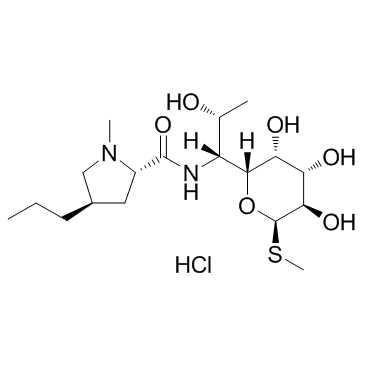859-18-7
| Name | Lincomycin hydrochloride |
|---|---|
| Synonyms |
(2S,4R)-N-{(1R,2R)-2-hydroxy-1-[(2R,3R,4S,5R,6R)-3,4,5-trihydroxy-6-(méthylsulfanyl)tétrahydro-2H-pyran-2-yl]propyl}-1-méthyl-4-propylpyrrolidine-2-carboxamide chlorhydrate
methyl 6,8-dideoxy-6-{[(4R)-1-methyl-4-propyl-L-prolyl]amino}-1-thio-D-erythro-a-D-galacto-octopyranoside hydrochloride (1:1) Frademicina Lincorex Methyl (5R)-5-[(1R,2R)-2-hydroxy-1-{[(4R)-1-methyl-4-propyl-L-prolyl]amino}propyl]-1-thio-β-L-arabinopyranoside hydrochloride (1:1) Lintamycin methyl 6,8-dideoxy-6-{[(4R)-1-methyl-4-propyl-L-prolyl]amino}-1-thio-D-erythro-α-D-galacto-octopyranoside hydrochloride Lincomycin (hydrochloride) Methyl 6,8-Dideoxy-6-((((2S,4R)-1-methyl-4-propyl-2-pyrrolidinyl)carbonyl)amino)-1-thio-D-erythro-a-D-galacto-octopyranoside Monohydrochloride (2S,4R)-N-{(1R,2R)-2-Hydroxy-1-[(2R,3R,4S,5R,6R)-3,4,5-trihydroxy-6-(methylsulfanyl)tetrahydro-2H-pyran-2-yl]propyl}-1-methyl-4-propylpyrrolidin-2-carboxamidhydrochlorid Lyncomycin,HCl (2S-trans)-Methyl 6,8-Dideoxy-6-[[(1-methyl-4-propyl-2-pyrrolidinyl)carbonyl]amino]-1-thio-D-erythro-a-D-galactooctopyranoside Monohydrochloride (2S,4R)-N-{(1R,2R)-2-hydroxy-1-[(2R,3R,4S,5R,6R)-3,4,5-trihydroxy-6-(methylsulfanyl)tetrahydro-2H-pyran-2-yl]propyl}-1-methyl-4-propylpyrrolidine-2-carboxamide hydrochloride EINECS 212-726-7 Lincolnensin Hydrochloride Lizpion Lincocin Lincomycin hydrochloride Methyl 6,8-dideoxy-6-{[(4R)-1-methyl-4-propyl-L-prolyl]amino}-1-thio-D-erythro-α-D-galacto-octopyranoside hydrochloride (1:1) Pelancocin MFCD00058237 LINCOMYCIN HCL D-erythro-α-D-galacto-Octopyranoside, methyl 6,8-dideoxy-6-[[[(2S,4R)-1-methyl-4-propyl-2-pyrrolidinyl]carbonyl]amino]-1-thio-, hydrochloride (1:1) D-erythro-α-D-galacto-octopyranoside, methyl 6,8-dideoxy-6-[[[(2S,4R)-1-methyl-4-propyl-2-pyrrolidinyl]carbonyl]amino]-1-thio-, monohydrochloride Lincogap Luniamycin D-erythro-a-D-galacto-octopyranoside, methyl 6,8-dideoxy-6-[[[(2S,4R)-1-methyl-4-propyl-2-pyrrolidinyl]carbonyl]amino]-1-thio-, hydrochloride (1:1) |
| Description | Lincomycin Hydrochloride(U10149A) is an antibiotic produced by Streptomyces lincolnensis var. lincolnensis.Target: AntibacterialLincomycin hydrochloride is a systemic antibiotic, which is active against most common gram positive bacteria. It has proved to be excellent for infectious diseases like acne, anthrax, pneumonia, and also for the treatment of furunculosis, carbuncles, impetigo, burns and wounds, carrying to gram positive bacteria. Lincomycin hydrochloride inhibits cell growth and microbial protein synthesis, by interacting strongly and specifically with the 50S ribosomal subunit, at mutually related sites [1-3]. |
|---|---|
| Related Catalog | |
| References |
| Boiling Point | 646.8ºC at 760 mmHg |
|---|---|
| Melting Point | 156-158ºC |
| Molecular Formula | C18H35ClN2O6S |
| Molecular Weight | 442.998 |
| Flash Point | 345ºC |
| Exact Mass | 442.190430 |
| PSA | 147.79000 |
| LogP | 0.27380 |
| Storage condition | 2-8°C |
| Water Solubility | H2O: 50 mg/mL, clear, colorless | Soluble in water. |
CHEMICAL IDENTIFICATION
HEALTH HAZARD DATAACUTE TOXICITY DATA
|
| Symbol |

GHS07 |
|---|---|
| Signal Word | Warning |
| Hazard Statements | H315-H319-H335 |
| Precautionary Statements | P261-P305 + P351 + P338 |
| Personal Protective Equipment | dust mask type N95 (US);Eyeshields;Gloves |
| Hazard Codes | Xi:Irritant; |
| Risk Phrases | R36/37/38 |
| Safety Phrases | S26 |
| RIDADR | NONH for all modes of transport |
| WGK Germany | 2 |
| RTECS | RH6315000 |
| HS Code | 2941904000 |
| HS Code | 2941904000 |
|---|

